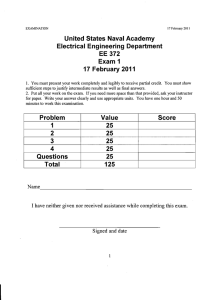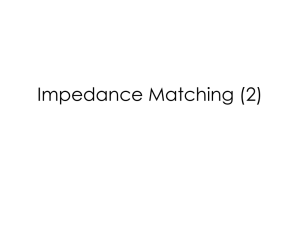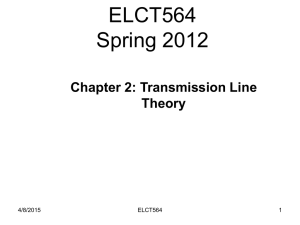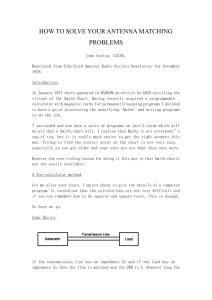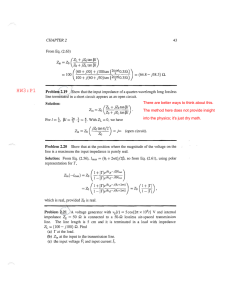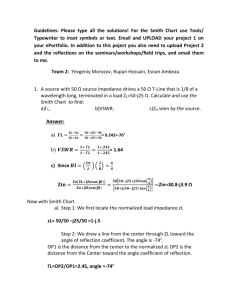Intro. to the Smith Chart
advertisement
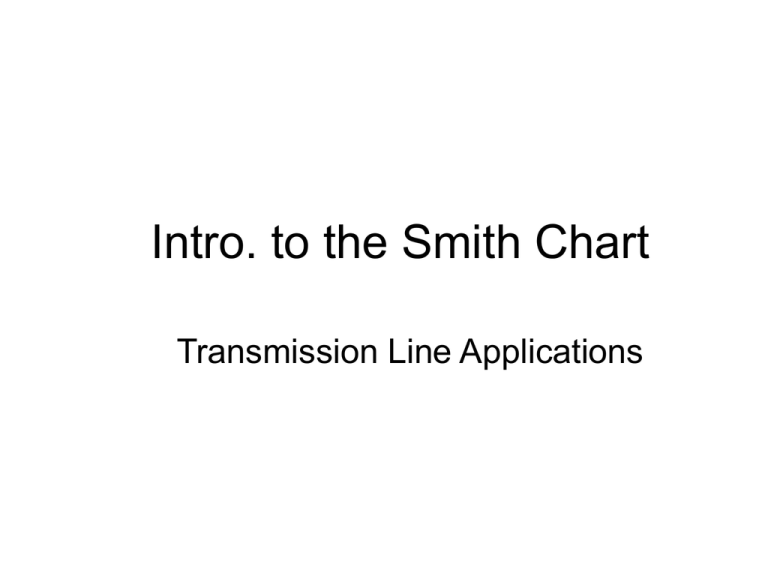
Intro. to the Smith Chart Transmission Line Applications Background • Philip Smith of Bell Laboratories developed the “Smith Chart” back in the 1930”s to expedite the tedious and repetative solution of certain rf design problems. These include: • Transmission line problems • Rf amplifier design and analysis • L-C impedance matching networks • Plotting of antenna impedance • Etc. CONSTRUCTION • The Smith Chart is made up of a family of circles and a second family of arcs of circles. • The circles are called “constant resistance circles” • The arcs are “constant reactance circles” • Impedances must be entered in rectangular form – broken down into a real and an imaginary component. • The real part (resistance) determines the circle to use. • The imaginary part (reactance) determines the arc to use. • The intersection of an arc and a circle represents the plotted impedance. Antenna Z known, find Z at transmitter ___________________________________________________________________ Assume an antenna impedance (ZL ) of 25 + j50 ohms Let characteristic impedance of the transmission line = 50 ohms Let velocity factor of cable (vf) = 0.66 Let physical line length = 100 feet = 30.48 meters Let the frequency (f) be 14.1 MHz ___________________________________________________________________ One electrical wavelength on cable = (983.6)(vf)/f(MHz) = (983.6)(.66)/14.1 = 46.04 ft. Wavelength of actual cable = 100 ft./46.04 ft. = 2.172 wavelengths or 781.9 degrees Subtract 0.5 wavelengths until the result is less than or equal to 0.5 wavelengths. The length to plot is 0.172 wavelengths or 61.9° (toward source). Normalize Load Z • Since the cable impedance is 50 ohms, we must divide the load impedance by 50 to plot it on the Smith Chart. • ZL (normalized) = (25 + j50)/50 • = 0.5 + j1.0 Plotting • Place a dot at 0.5+ J1.0 • Extend a radial line from the center through 0.5+j1.0 to the “wavelengths toward generator” scale on the periphery. • Read approx. 0.1345 • Add 0.172 to get 0.3065 • Extend another radial line from the center through 0.3065 on the “wavelengths toward generator” scale. Plotting Cont’ • Place one leg of your dividers on the center and the other leg on 0.5+j1.0 • Draw an arc clockwise (0.172 wavelengths) to the second radial. • Read approx. 1.4 – j1.8 at the intersection. • Multiple by 50 to un-normalize. • Z at sending end is approx. 70-j90 ohms (An inductive antenna impedance looks capacitive at the transmitter.) Input Impedance (Zin) of a lossless transmission line : ______________________________________________________________________________________ define "j" j 1 ______________________________________________________________________________________ Problem parameters: l 100ft 61.9deg Zo 50 ZL 25 50j ________________________________________________________________________________________ ZL cos j sin Zo Zin Zo ZL cos j sin Zo ________________________________________________________________________________________ Ans w er: Zin 68.766 90.794i OHMS FCG 12-26-09


